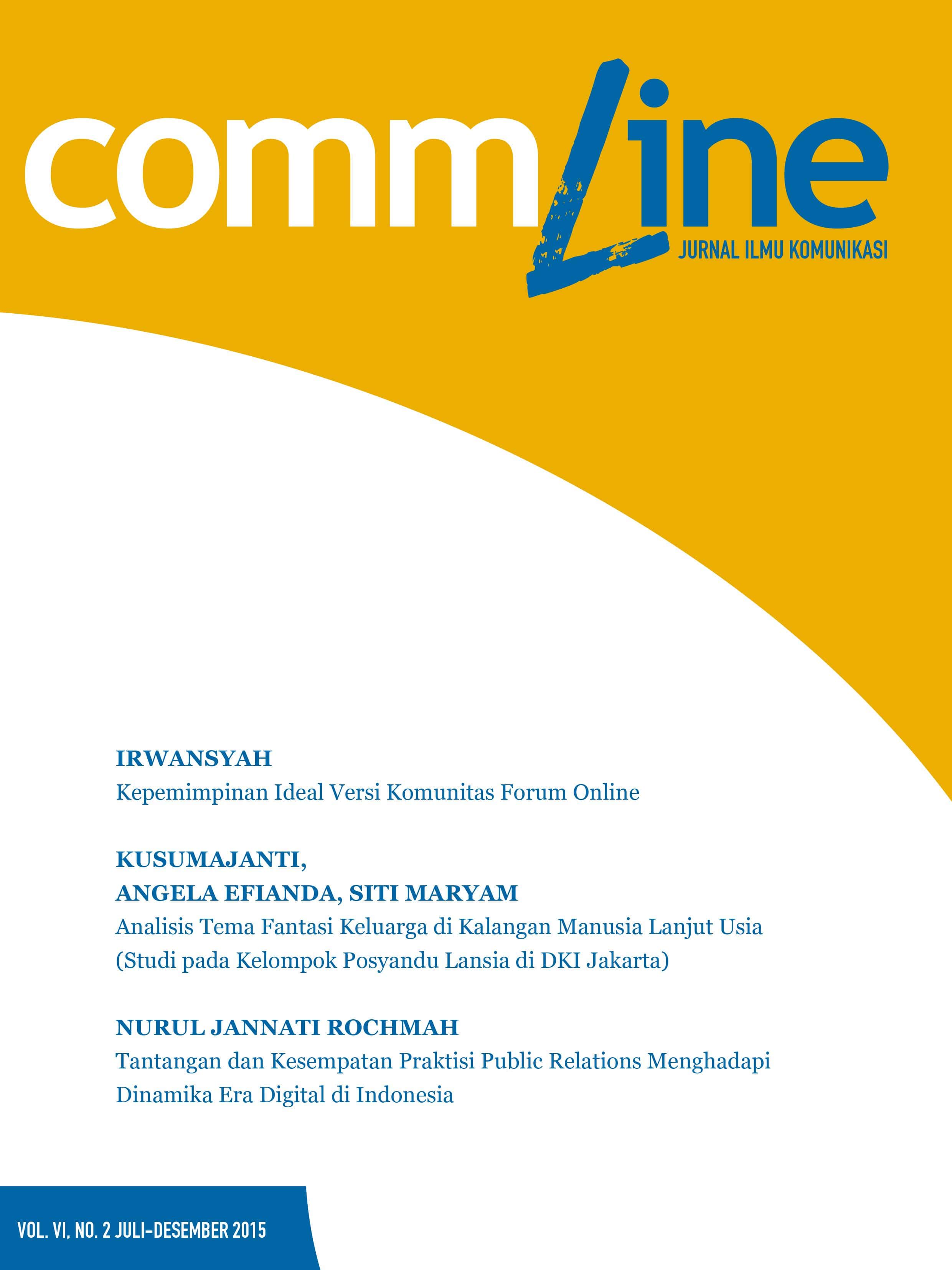Analisis Tema Fantasi Keluarga di Kalangan Manusia Lanjut Usia (Studi pada Kelompok Posyandu Lansia di DKI Jakarta)
Kata Kunci:
Theme of fantasy, group communicaion, older persons (senior citizen)Abstrak
This study was a long-term consideration of the Ministry of Social Affairs and communities in handling the problems of older persons (senior citizen) in Indonesia. Spe cific target of this research was to utilize themes of fantasy in each group meeting of the Elderly to be able to create cohesion among the group members. The research was using qualitative methods to analyze the family’s themes of fantasy in every story of the elderly. The data were obtained from observations of meetings and inÂdepth interviews to members of the elderly and their families in the environtment. The research analyzed the themes of fantasy that often appeared in every meeting where the elderly like the theme of family and health. The stories were developed by using jokes and funny stories to create happiness and equality symbol on the family and health. The use of fantasy as a result of the reconstruc tion of consciousness embodied in various rhetorical fantasy of the past, to create cohesion among the group of seniors. This study showed that the cohesiveness as the strength of all the factors that encourage members to survive in the group.
Referensi
Arianto, (2012), Tema-Tema Fantasi dalam Komunikasi Kelompok Muslim-Tionghoa, Jurnal Ilmu Komunikasi, vol. 10, No. 1, pp 1-12
Benoit William, Klyukovski Andrew, McHale John, Airne David, (2001), A Fantasy Theme Anal ysis of Political Cartoons on ClintonÂLewin sky-Starr Affair, Critical Studies in Media Com- munication, vol. 18, issue 4, pp. 377-394
Berkowitz, L., (1954), Group Standards, Cohesive ness, and Productivity, Human Relations, vol. 7, pp. 509-519
Bormann, EG, (1972), Fantasy And Rhetorical Vision: The Rhetorical Criticism Of Social Re ality, Quarterly Journal of Speech, vol. 58, pp. 396-407
Bormann, EG, (1973), The Eagleton Affair: A Fan tasy Theme Analysis, Quarterly Journal of Speech, vol. 59, issue 2, pp. 143-159
Bormann, EG, (1982a), A Fantasy Theme Analy sis of The Television Coverage of The Hostage Release and The Reagan Inaugural, Quarterly Journal of Speech, vol. 68, issue 2, pp. 133-145
Bormann, EG, (1982b), The Symbolic Convergence Theory Of Communication: Applications And Implications For Teachers And Consultants, Journal of Applied Communication Research, vol. 10, no. 1, Spring82, p. 50.
Bormann, EG,(1983), Symbolic Convergence: Or ganizational Communication And Culture, in Communication and Organizations: an Inter pretive Approach, eds. LL Putnam & ME Pacanowsky, Sage, Beverly Hills, CA, pp. 99-122.
Bormann, EG, Kroll BS, Watters Kathleen, McFar- land, Douglas, 1984, Rhetorical Visions of Com mitted Voters: Fantasy Theme Analysis of A Large Sample Survey, Critical Studies in Mass Communication, vol. 1, issue 3, pp. 287-310
Bormann, EG, 1985, Symbolic Convergence Theo ry: A Communication Formulation, The Jour- nal of Communication, vol. 35, pp. 128-138
Bormann, EG, 2000, The Force of Fantasy: Restor ing The American Dream, Carbondale, Illinois: Southern Illinois University Press
Bormann, E. G., Cragan, J. F., & Shields, D. C., 1994,
In Defense of Symbolic Convergence Theory: A Look at The Theory and Its Criticisms After Two Decades, Communication Theory, vol. 4, issue 4, pp. 259-294
Bormann, EG, Knutson, Roxann L, Musolf, Karen, 1997, Why Do People Share Fantasies? An Em pirical Investigation of A Basic Tenet of The Sym bolic Convergence Communication Theory, Communication Studies, vol. 48, issue 3, pp. 254-276
Bormann, E. G., Cragan, J. F., & Shields, D. C., 2003,Defending Symbolic Convergence Theory from an Imaginary Gunn, Quarterly Journal of Speech, vol. 8, issue 4, pp. 366-372.
Charles, S.T., Carstensen,I.L (2007). Emotion RegÂ
ulation and Aging, dalam J.J. Gross (Editor), Handbook of Emotion Regulation (hlm. 307Â 330). New York: Guiltford
Cornwell,B., Laumann,E.O., dan Schumm,L.P. (2008). The Social Connectedness of Older Adukts: A National Profile, American Sociolog- ical Review, 73, pp. 185-203
Crooks, V.C., Lubben, J., Petitti, D.B., Little,D., Chiu, V. (2008). Social Network, Cognitive Function, and Dementia Incidence Among Elderly Women. American Journal of Public Health, 98, pp. 1221-1227
Denzin, Norman K., Yvonna s. Lincoln (2003). In troduction: In Strategies of Qualitative Inqui ry. 2nd ed. Edited by N. Denzin and Y. Lincoln, pp 1-45. Thousand Oaks, CA:Sage
Haskell, Robert E, 1988, Small Group “Fantasy Theme†Analysis, Antrophology And Psycholo gy: A Comparative Study of The Psychosocial Structure of Ceremony, The Journal of Psycho- history, vol. 16, issue 1, pp. 61-78
Haskell, Robert E, (1991), An Analogical Methodol ogy for Analysis and Validation of Anomalous Cognitive and Linguistic Operations in Small Group (Fantasy Theme) Report, Small Group Research, vol. 22, issue 4, pp. 443-474
Hawkley,L.C., Cacioppo, J.T. (2007). Aging and Loneliness: Downhill Quickly? Current Direc- tions in Psychological Science, Vol. 16, pp. 187-191
Kartikawangi, Dorien, (2013), Tema Fantasi: Strategi Komunikasi Bisnis Perusahaan Multi nasional, Jakarta, Gramedia Pustaka Utama
Littlejohn, Stephen.W, Foss, Karen A, (2008), The ories of Human Communication, 9th ed., Singa- pore, Cengage Learning Asia
Papalia, D.F., Feldman, R.D. (2014). Experience Human Development 12th ed, 2nd book. Mc- Graw-Hill Education (Asia)
Sarwono, Sarlito Wirawan, (2005), Psikologi So sial: Psikologi Kelompok dan Psikologi Tera pan Cetakan keÂ3, Jakarta, Balai Pustaka
Schacter, S., Ellertson, N., McBride, D., & Gregory, D, (1951),An Experimental Study of Cohesive ness and Productivity. Human Relations, Vol. 4, pp. 229-238
Supratiknya, A. (1995), Komunikasi Antar Pribadi, Tinjauan Psikologis. Yogyakarta, Kanisius
Terry, Valerie Sue, (1998), Lobbyists and Symbolic Convergence in The Public Policy Arena: Ex ploring The Nature and Significance of Persua sion in LobbyingÂStyle Communication, disser- tations Publishing, Purdue University, United State—Indiana
West, Richard & Turner, Lynn H., (2007). Intro ducing Communication Theory: Analysis and Application, 3nd ed., New York, McGraw-Hill
Yin, Robert.K. (2009). Case Study Research Design and Methods 4th ed. Applied Social Research Methods Series Vol. 5. Singapore: Sage

